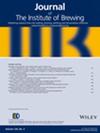The lowering of gushing potential from hydrophobin by the use of proteolytic enzymes
IF 2.4
3区 农林科学
Q3 FOOD SCIENCE & TECHNOLOGY
引用次数: 0
Abstract
Why was the work done: Gushing caused by hydrophobin originating from field fungal contamination of grain remains a significant problem in certain regions. We sought to explore whether the use of added proteinase enzymes could overcome the problem and allow the use of problematic grain. How was the work done: Four commercial proteinases were studied for their ability to digest hydrophobin and remove its foaming potential. One of those enzymes was then explored for its utility as an addition to mashing with a view to lowering the gushing potential of the ensuing beer. What are the main findings: The four enzyme preparations (Smizyme LP-G, Thermoase PC, Bromelain and Papain) were all capable of digesting hydrophobin. Of these, papain was chosen to assess whether the use of such an enzyme in mashing could ameliorate the gushing potential in finished beers. It was demonstrated that this can be achieved and without apparent detriment to the foaming potential of those beers. Why is the work important: It is now possible for brewers to consider an alternative approach to rectifying gushing risks if they are confronted with problematic grain. It must be stressed that this technique will not address the other main risk from infections of this type, namely the production of mycotoxins. Even in a context where gushing is not a problem, this work has indicated that there should be little concern with addition of papain at the mashing stage from a perspective of decreasing the foaming performance of beer.使用蛋白水解酶降低亲水蛋白的喷涌势能
为什么要开展这项工作:在某些地区,谷物受到田间真菌污染后产生的亲水蛋白导致的涌水仍然是一个严重问题。我们试图探索使用添加的蛋白酶是否能克服这一问题,并允许使用有问题的谷物:我们研究了四种商业蛋白酶消化疏水性蛋白和消除其发泡潜力的能力。然后研究了其中一种酶作为糖化添加剂的效用,以期降低随后啤酒的喷涌潜力:四种酶制剂(Smizyme LP-G、Thermoase PC、菠萝蛋白酶和木瓜蛋白酶)都能消化疏水性蛋白。在这些酶制剂中,选择木瓜蛋白酶是为了评估在糖化过程中使用这种酶制剂是否能改善成品啤酒的喷涌潜力。这项工作的重要性:如果酿酒师遇到有问题的谷物,现在可以考虑采用另一种方法来纠正涌泉风险。必须强调的是,这种技术无法解决此类感染的另一个主要风险,即霉菌毒素的产生。即使在没有涌出问题的情况下,这项工作也表明,从降低啤酒发泡性能的角度来看,在糖化阶段添加木瓜蛋白酶的问题不大。
本文章由计算机程序翻译,如有差异,请以英文原文为准。
求助全文
约1分钟内获得全文
求助全文
来源期刊

Journal of The Institute of Brewing
工程技术-食品科技
CiteScore
6.20
自引率
7.70%
发文量
25
审稿时长
6 months
期刊介绍:
The Journal has been publishing original research for over 125 years relating to brewing, fermentation, distilling, raw materials and by-products. Research ranges from the fundamental to applied and is from universities, research institutes and industry laboratories worldwide.
The scope of the Journal is cereal based beers, wines and spirits. Manuscripts on cider may also be submitted as they have been since 1911.
Manuscripts on fruit based wines and spirits are not within the scope of the Journal of the Institute of Brewing.
 求助内容:
求助内容: 应助结果提醒方式:
应助结果提醒方式:


